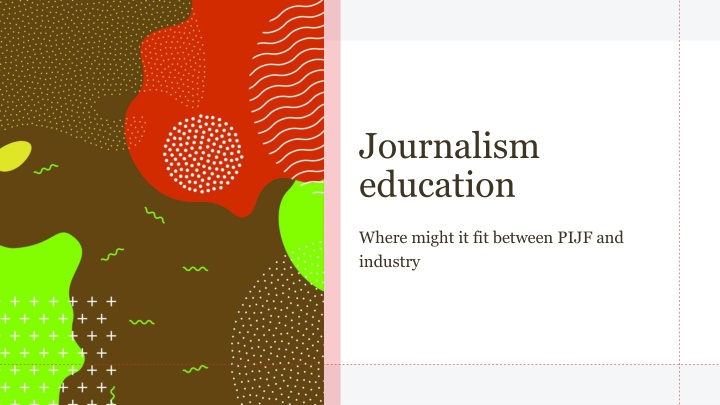
Evolution of Journalism Education in New Zealand
Discover the changing landscape of journalism education in New Zealand, with a focus on curriculum revisions, industry relevance, and the need for stronger industry-education connections. Explore the demand for journalism schools and the shift towards practical, skills-oriented training. Learn about the challenges faced, such as lack of mid-career support and churn in the industry, and explore innovative ideas for collaboration and improvement.
Download Presentation

Please find below an Image/Link to download the presentation.
The content on the website is provided AS IS for your information and personal use only. It may not be sold, licensed, or shared on other websites without obtaining consent from the author. If you encounter any issues during the download, it is possible that the publisher has removed the file from their server.
You are allowed to download the files provided on this website for personal or commercial use, subject to the condition that they are used lawfully. All files are the property of their respective owners.
The content on the website is provided AS IS for your information and personal use only. It may not be sold, licensed, or shared on other websites without obtaining consent from the author.
E N D
Presentation Transcript
Journalism education Where might it fit between PIJF and industry
Journalism Schools are in demand Approximate Approximate figures figures studying studying, , graduating graduating Undergraduate Undergraduate journalism journalism majors (second majors (second & 3 & 3rd year) Postgraduate, Postgraduate, graduate graduate diplomas diplomas 1 year 1 year Total Total graduates last graduates last year year rdyear) Canterbury 32 7 20 Ara (Broadcasting School) 60 - 20 AUT 70 12 46 Wintec Not available Massey 140 15 56 Totals 301 27 142 - Graduating numbers most important figure - Numbers represent multiple pathways to their training/study - There is no one-size-fits-all model to journalism training - Students want internationally recognised qualifications
Journalism education changes All courses have been revised in the past three years Heavily skills oriented Most assessments are journalism work delivered as portfolios Internships are included Delivery now by distance and part-time Little classroom time Transformed in past five years
15 to 20 teachers across the country All former journalists Who delivers the content 10-15 years experience minimum in industry Supplemented by industry tutors and guest speakers
Teaching not just for mainstream Broader, diversified market of journalism employers Pay levels can be $21 an hour High rents as students transition from student lifestyle Issues to be addressed Lack of mid-career support Churn in industry Lack of overarching industry-education connection since middle of last decade Industry report and project advertising journalism education Conflicts with communication we have with newsrooms
Ideas from journalism education PIJF has brought us together Let s collaborate, work together, we re too small a country not to An paid apprenticeship scheme for graduates is logical There are local and international models provide inspiration Mentoring would be a critical element of such a scheme


















